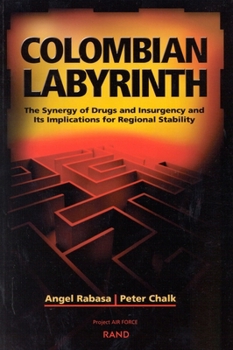Colombian Labyrinth: The Synergy of Drugs and Insugency and Its Implications for Regional Stability
U.S. policy toward Colombia has been driven to a large extent by counter-narcotics considerations, but the evolving situation in that South American country confronts the United States with as much of a national security as a drug policy problem. Colombia is a geostrategically important country, whose trajectory will influence broader trends in the
Format:Paperback
Language:English
ISBN:0833029940
ISBN13:9780833029942
Release Date:July 2001
Publisher:RAND Corporation
Length:132 Pages
Weight:0.50 lbs.
Dimensions:0.5" x 5.9" x 8.8"
Customer Reviews
3 ratings
Tier-one research & honest comments
Published by Thriftbooks.com User , 21 years ago
I was impressed that the funding for this Rand study was provided by the U.S. Air Force. It is good to know a key player in the Pentagon is interested in the fundamental facts about Colombia free of the Washington Beltway political sugar-coating. To this end, "Colombian Labyrinth; The Synergy of Drugs and Insurgency and Its Implications for Regional Stability," is filled with tier-one research and honest comments. To begin with authors Angel Rabasa and Peter Chalk carefully explain the weakness of the Colombian government. Certainly conditions have improved in Colombia since the publication of this text in June of 2001 but government power still resides in the big cities and is diminished in the countryside. However, the one nugget of research that the authors wisely publish is that Colombia has some of the largest untapped petroleum reserves in the Western Hemisphere. It helps explain why Colombia is the third largest receiver of U.S. foreign aid in the world after Israel and Egypt.Still and all, a big point of this book is that the heralded President Clinton/Pastrana "Plan Colombia" U.S. aid program is a "doubtful strategy," according the the authors. Moreover, the central government's loss of authority, economic deterioration, social disintegration, the development of an underground criminal drug economy and the dangerous growth of armed challenges to the state's authority are all well-documented and discussed. The text also offers sound advice to the core problems, particularly the human rights violations by the violent actors in Colombia. Overall, this sleek and compact book is a valuable guide to the complexity of the crisis in Colombia.Bert Ruiz
Colombian labyrinth
Published by Thriftbooks.com User , 21 years ago
Colombian labyrinth is an objective, concise study of Colombia's instability as it unfolds from the interaction of criminal drug economies and growth of armed challenges to the state's authority. The study revolves about the three-sided civil conflict (government, guerrilla and self-defense groups) and how each one of them plays a critical role in the Colombian stability. On one hand, the study concisely touches upon the scope and the dimensions of the drug-insurgency problem, origins of the main players (guerrilla, self-defense groups), and their strategies. On the other hand, it discusses the Colombian government's response to the crisis in the form of peace negotiations, and the counter-narcotics U.S. assisted strategy, Plan Colombia (Colombian Project). In addition, it briefly presents a number of though-provoking scenarios for the Colombian state as a result of different circumstances. The study finishes by examining the spread of the conflict to neighboring countries and their respective response. Unfortunately, the study does not elaborate on the U.S. repercussions as they derive from the synergies of drug-insurgency complex.
Colombian Labyrinth
Published by Thriftbooks.com User , 23 years ago
COLOMBIAN LABYRINTH is an uneven but generally useful study of the drugs-insurgency nexus in Colombia and its significance for U.S. policy. The discussion of the illicit drug business breaks little new ground and misses important post-cartel dynamics such as the FARC's increased downstream participation in the business as traders and even exporters. On the other hand military-strategic topics such as the guerrillas' force structure and power seeking strategies, the military requirements for countering the growing guerrilla threat, and the implications of Colombia's civil conflict for regional stability are handled quite successfully. The authors point to the sometimes competing imperatives of drug-fighting and counter-insurgency--a difficulty epitomized by the dysfunctional coca spraying campaign--and argue correctly that U.S. policy should give priority to strengthening Colombian state institutions,including the military.(They might have recalled the example of Peru, which suspended eradication of coca at the end of the 1980s to garner rural support for the fight against Sendero,) The discussion of alternative Colombian futures is gloomy but thought-provoking and well worth the attention of Colombia specialists and policymakers. A scenario that might have been mentioned is the devolution of the FARC, or parts of the movement, into a preeminently criminal organization with a scaled down political agenda--seeking, perhaps, a free hand to traffic in drugs within defined spheres while acknowledging the overall authority of the Colombian state.






